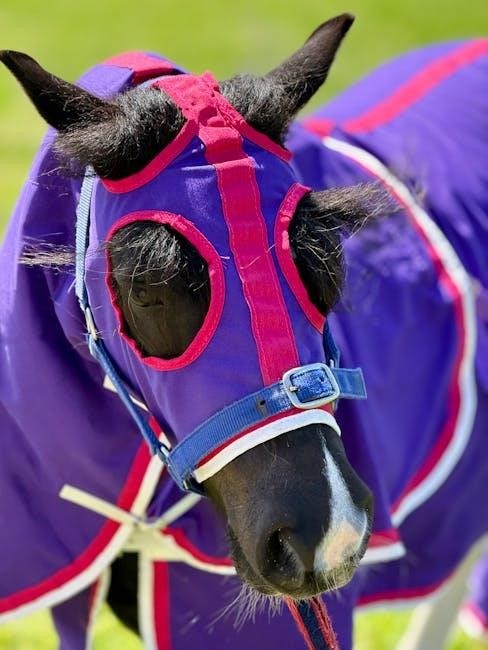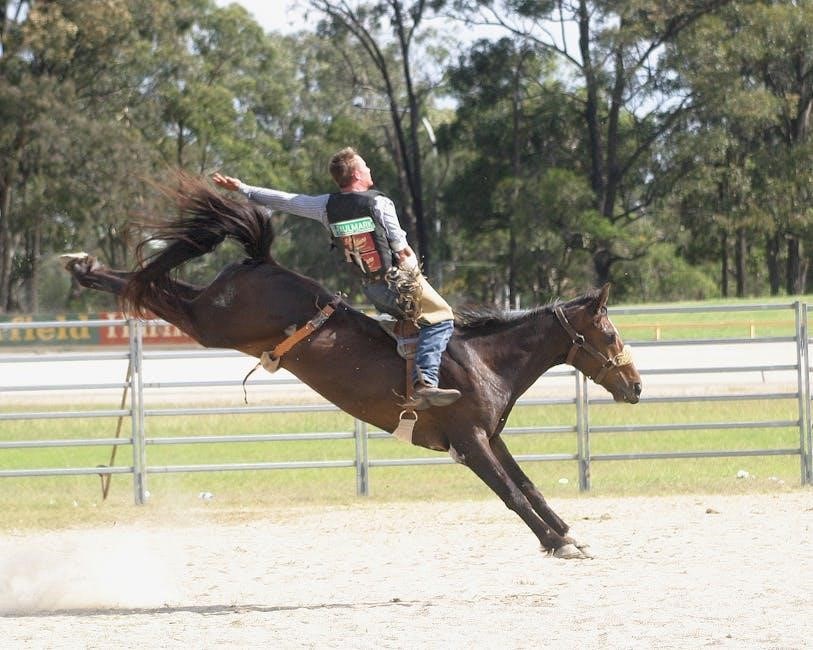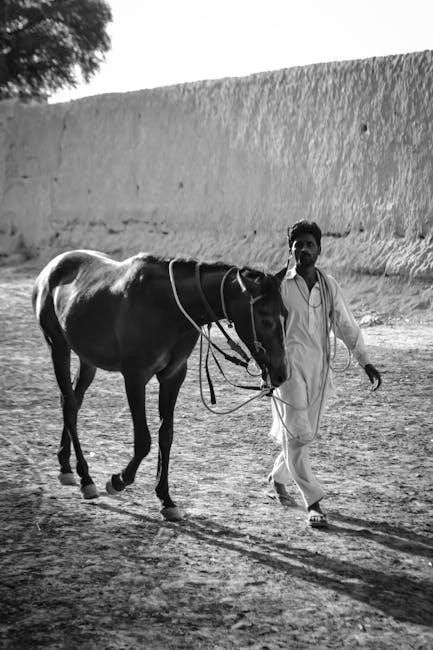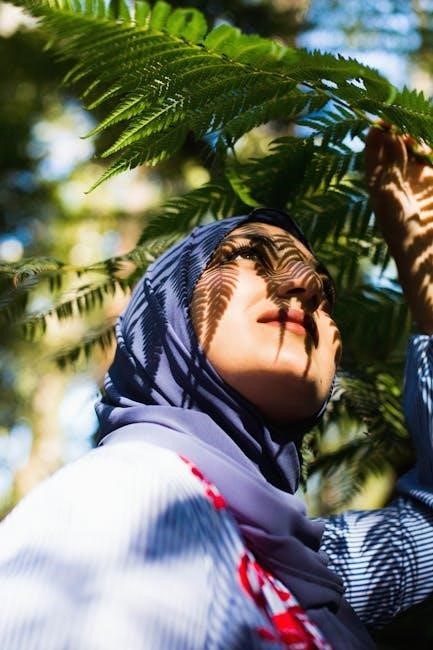Australia’s diverse climate requires tailored rugging strategies to ensure horses remain comfortable. This guide helps horse owners understand temperature regulation, covering key factors like weather, health, and coat condition to make informed decisions.
Understanding the Importance of Temperature Regulation for Horses
Horses naturally regulate their body temperature, but extreme weather can challenge this process. A horse’s normal temperature ranges from 98°F to 101°F, and maintaining this balance is crucial for health and comfort. Proper rugging helps protect against cold stress, especially in harsh Australian winters. Signs of cold discomfort include shivering, stiffness, and cold ears, indicating the need for appropriate rugging to support their natural thermoregulation.
Overview of Climate Zones in Australia and Their Impact on Horse Rugging
Australia’s climate varies significantly across regions, influencing horse rugging needs. Northern areas experience tropical conditions, requiring lightweight rugs, while southern regions face colder winters, demanding heavier rugs. Coastal zones may need waterproof options due to high rainfall, and inland areas often require adaptable rugging for extreme temperature fluctuations. Understanding these climate differences is key to selecting the right rug for your horse’s comfort and health.

Factors Influencing Rugging Decisions
Weather conditions, a horse’s age, health, coat condition, and living environment significantly impact rugging choices, ensuring comfort and protection across varying Australian climates and seasons.
Weather Conditions: Temperature, Humidity, Wind, and Rain
Temperature is a primary factor, with rugging needed below 10°C. Humidity and wind chill can exacerbate cold, while rain necessitates waterproof rugs. Monitoring these elements ensures optimal comfort and protection for horses in varying Australian climates, preventing overheating or chilling. Adjusting rugs based on weather changes is crucial for maintaining health and well-being;
Horse’s Age, Health, and Coat Condition
Young, elderly, or sick horses may need extra warmth due to reduced natural insulation. Those with clipped coats or health issues require closer monitoring. A horse’s coat thickness and condition guide rug selection, ensuring they stay comfortable without overheating. Regular checks help tailor rugging to individual needs, promoting overall health and preventing discomfort or stress.
Stabling vs. Grazing: How Environment Affects Rugging Needs
Horses in stables often need more rugging due to colder, draft-free conditions, while grazed horses benefit from natural shelter and movement. Stabled horses may require heavier rugs, especially in cold weather, whereas pastured horses rely on their natural coats and activity for warmth. Environment plays a crucial role in determining the appropriate rug weight and type for optimal comfort and health.

Types of Horse Rugs and Their Uses
Horse rugs vary in weight and design, including lightweight, medium, heavyweight, and waterproof options, each tailored for specific weather conditions to ensure comfort and protection.
Lightweight Rugs (50g-150g) for Mild Temperatures
Lightweight rugs (50g-150g) are ideal for mild temperatures, typically between 5°C and 10°C. They provide minimal insulation without overheating, suitable for spring or autumn. These rugs are perfect for horses that are sensitive to cold but don’t require heavy coverage. They often feature breathable materials to prevent moisture buildup, ensuring comfort and protection in cooler yet not freezing conditions.
Medium Weight Rugs (200g-300g) for Cool Weather
Medium weight rugs (200g-300g) are designed for cooler conditions, typically between 0°C and 5°C. They offer moderate insulation, making them ideal for horses that need protection from chill without overheating. These rugs are breathable, preventing moisture buildup, and are suitable for clipped horses or those exposed to wet and windy conditions. They strike a balance between warmth and comfort, ensuring horses remain cozy in cool weather.
Heavyweight Rugs (400g+) for Freezing Conditions
Heavyweight rugs (400g+) are essential for extreme cold, typically below 0°C. Designed to provide maximum insulation, these rugs often feature waterproof and breathable materials, ensuring horses stay warm and dry. They are ideal for prolonged exposure to freezing temperatures, especially when combined with wind or rain. Look for rugs with neck covers for added protection. Proper fit is crucial to avoid rubbing and ensure optimal warmth during harsh winter conditions.
Waterproof and Rain-Resistant Rugs for Wet Weather
Waterproof and rain-resistant rugs are crucial for protecting horses in wet conditions. These rugs are designed to repel water while maintaining breathability, preventing moisture buildup. They are ideal for heavy rain or prolonged exposure to damp environments.
Look for rugs with secure fittings to ensure they stay in place during wind or rain; Pairing them with a lightweight under-rug in colder temperatures enhances warmth and comfort, making them a practical choice for Australia’s unpredictable wet weather.
Temperature Guidelines for Rugging
This guide provides temperature-based recommendations for selecting appropriate horse rugs, ensuring comfort across Australia’s varied climate zones. From no rug needed at 10-20°C to lightweight, medium, and heavyweight options for colder conditions, this guide tailors rugging to Australian weather.
When to Use No Rug (10-20 Degrees Celsius)
At temperatures between 10-20°C, horses typically do not require rugging as they can regulate their body heat naturally. Their coats effectively insulate, maintaining comfort without additional layers. However, if your horse is clipped or exposed to harsh winds, a lightweight rug may be considered. Above 15°C, no rug is usually needed, while between 10-15°C, it depends on individual comfort. Always monitor your horse’s condition and adjust accordingly to prevent overheating or discomfort.
When to Use a Lightweight Rug (5-10 Degrees Celsius)
Lightweight rugs with 50g-150g fill are ideal for temperatures between 5-10°C. They provide gentle warmth without causing overheating. Use them if your horse is clipped, elderly, or has a thinner coat. Ensure the rug is breathable and moisture-wicking to prevent chilling from sweat. Avoid using heavier rugs in this range to keep your horse comfortable and prevent heat stress. Monitor weather conditions and your horse’s response to adjust rugging as needed.
When to Use a Medium Weight Rug (0-5 Degrees Celsius)
For temperatures between 0-5°C, a medium weight rug (200g-300g) is suitable. It provides adequate warmth without causing overheating. Ideal for clipped horses or those with thinner coats, medium weight rugs help maintain comfort in cooler conditions. Consider waterproof options if rain or wind is present. Monitor your horse’s comfort, as some may prefer lighter or heavier rugs depending on their health and acclimatization to cold weather.
When to Use a Heavyweight Rug (Below 0 Degrees Celsius)
For temperatures below 0°C, a heavyweight rug (400g+) is essential to keep your horse warm and dry. These rugs are designed for extreme cold, providing maximum insulation. They are particularly beneficial for unclipped horses in freezing conditions or those exposed to harsh winds. Ensure the rug is waterproof to protect against snow and ice, and consider adding a neck cover for extra warmth and protection against the elements.

Signs Your Horse Needs a Rug
Shivering, cold ears, stiffness, or raised hair indicate your horse may need a rug. Behavioral signs like restlessness or lack of appetite can also signal discomfort from cold.
Physical Indicators: Shivering, Cold Ears, Stiffness
Shivering is a clear sign your horse is struggling to stay warm, as it generates heat through muscle movement. Cold ears or a chilly back indicate poor circulation and discomfort. Stiffness or reluctance to move may suggest your horse is cold and uncomfortable. These physical cues are essential for determining when to introduce a rug, especially in colder climates or wet conditions.
Behavioral Indicators: Restlessness, Lack of Appetite
Restlessness or pacing may indicate your horse is uncomfortable due to cold. A lack of appetite can also signal distress, as cold stress affects digestion. These behaviors suggest your horse needs a warmer rug. Monitoring these signs helps prevent health issues, ensuring your horse stays comfortable and thrives in colder conditions.

How to Check if Your Horse’s Rug is the Right Temperature
Use the hand test by placing your palm behind the withers to feel for warmth. Check if the coat is flat or standing on end, indicating cold stress.
The Hand Test: Checking for Warmth Behind the Withers
To perform the hand test, place your palm gently behind your horse’s withers. If the area feels cool or cold, it may indicate the rug is insufficient. If it’s overly warm, the rug might be too heavy. The ideal temperature is a comfortable, even warmth. This simple method helps ensure your horse is neither too cold nor overheating, promoting optimal comfort and health.
Monitoring Coat Condition and Hair Orientation
Regularly inspect your horse’s coat to ensure proper rugging. A well-rugged horse should have a smooth, lying coat. If hairs stand on end, it may signal cold stress, while a damp or matted coat indicates overheating. Check for even warmth and dryness, especially under the rug, to prevent discomfort and health issues. Adjusting the rug based on these observations ensures your horse stays comfortable in varying conditions.
Maintenance and Care of Horse Rugs
Regular cleaning and proper storage are crucial for extending rug life. Wash rugs seasonally, repair tears promptly, and ensure they dry thoroughly to prevent mold and odors.
Regular Cleaning and Drying to Prevent Mold
Regular cleaning and drying of horse rugs are essential to prevent mold growth. Brush off dirt and sweat regularly and wash rugs with mild detergent. Ensure rugs are completely dry before storage to avoid mold. Proper care extends rug life and keeps your horse comfortable and healthy.
Ensuring Proper Fit to Avoid Rubbing or Restriction
A well-fitting rug is crucial to prevent discomfort and injury. Ensure the rug sits comfortably across the horse’s back, with adequate shoulder room and even coverage. Regularly check for signs of rubbing or restriction, such as hair loss or redness. Adjust or replace rugs as needed to maintain your horse’s comfort and mobility throughout the season.
Regional Variations in Rugging Needs Across Australia
Australia’s climate varies significantly, from tropical north to temperate south, requiring tailored rugging strategies. Regional temperature differences and weather patterns demand localized approaches to ensure horse comfort and health.
Temperature and Climate Differences Between Northern and Southern Regions
Australia’s northern regions experience warmer, humid climates, while southern areas face cooler temperatures and colder winters. Northern horses may need lightweight rugs for mild winters, while southern horses require heavier rugs to combat freezing conditions. Coastal regions often have milder winters compared to inland areas, which can experience extreme cold. Understanding these variations is crucial for selecting appropriate rugs to keep horses comfortable year-round.
Adjusting Rugging Strategies for Coastal vs. Inland Areas
Coastal regions generally have milder temperatures with less extreme cold, allowing for lighter rugging. In contrast, inland areas often experience colder winters and greater temperature fluctuations, necessitating heavier rugs. Coastal horses may benefit from breathable, waterproof rugs due to higher humidity and rain, while inland horses require rugs with higher fill weights to protect against harsh, dry cold. Adaptation is key to maintaining comfort.
Understanding temperature and weather conditions is crucial for proper rugging. Always consider your horse’s specific needs, and monitor regularly to ensure their comfort and well-being in varying climates.
Final Tips for Choosing the Right Rug for Your Horse
Always consider weather forecasts, your horse’s age, health, and coat condition. Use the hand test to check warmth behind the withers. Avoid over-rugging, as it can cause discomfort. Ensure proper fit to prevent rubbing or restriction. Monitor for signs of cold, such as shivering or stiffness. Adjust rugging based on temperature changes and your horse’s individual needs for optimal comfort and well-being.
Importance of Monitoring and Adjusting Rugging Based on Weather Changes
Regularly monitor weather conditions to ensure your horse’s rug remains suitable. Adjust the rug weight or type as temperatures fluctuate to prevent over-heating or under-warming. Check for signs of discomfort, such as sweating or shivering. Keep your horse comfortable by adapting their rugging to match changing weather patterns, ensuring their well-being throughout varying Australian climates and seasons.


